

Hinduism. Hindu mythology. Hindu mythology is a large body of traditional narratives related to Hinduism as contained in Sanskrit literature (such as the epics like Mahabharata and Ramayana, the Puranas, and the Vedas), Ancient Tamil literature (such as the Sangam literature and Periya Puranam), several other works, most notably the Bhagavata Purana, claiming the status of a Fifth Veda and other religious regional literature of South Asia.
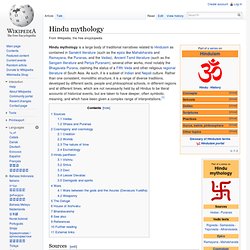
As such, it is a subset of Indian and Nepali culture. Rather than one consistent, monolithic structure, it is a range of diverse traditions, developed by different sects, people and philosophical schools, in different regions and at different times, which are not necessarily held by all Hindus to be literal accounts of historical events, but are taken to have deeper, often symbolic, meaning, and which have been given a complex range of interpretations.[1] Sources[edit] Vedas[edit] Itihasa and Puranas[edit]
A Brief Introduction to Hinduism. Would you like to make this site your homepage?
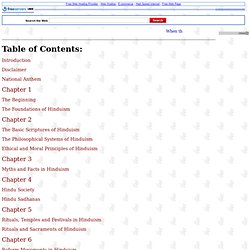
It's fast and easy... Yes, Please make this my home page! Don't show this to me again. Table of Contents: Introduction Disclaimer National Anthem Chapter 1. Hinduism & Sanatana Dharma. Hindusim means Sanatana Dharma.

Hinduism was coined by outsiders, and it means who do not practice Islam, Zohrastrian, Christianity or Judaism, and practised by the people who live in geographical region of Hindu {land between Himkhand (Himalaya) and Indu Samudra (Indian Ocean) - MahaShivpurana, Rudrasamhita-Yuddhakhanda}. Is it a religion or a way of life? I believe it is both. It is based on “Puranik” scriptures of Vedic culture.
Veda is science. There are many misconceptions about Hinduism. People in ancient Bhaaratvarsha used to follow Sanatana Dharma. Prof. Mridu Rai: Caste system in India Shiva Lingam - Meaning and the myths. The Sanskrit word ‘ Lingam’ means symbol.
Yuga. Yuga (Devanāgari: युग) in Hindu philosophy is the name of an epoch or era within a four age cycle.

According to Hindu cosmology, life in the universe is created and destroyed once every 4.1 to 8.2 billion years,[1][2] which is one full day (day and night) for Brahma. History of Hinduism. Hinduism (Sanskrit सिन्धु "Sindhu" (Indus River) + ism) is a term for a wide variety of related religious traditions native to India.
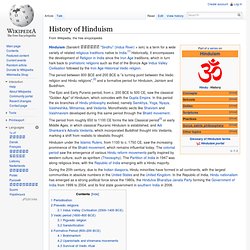
Historically, it encompasses the development of Religion in India since the Iron Age traditions, which in turn hark back to prehistoric religions such as that of the Bronze Age Indus Valley Civilisation followed by the Iron Age Historical Vedic religion. The period between 800 BCE and 200 BCE is "a turning point between the Vedic religion and Hindu religions", and a formative period for Hinduism, Jainism and Buddhism. The Epic and Early Puranic period, from c. 200 BCE to 500 CE, saw the classical "Golden Age" of Hinduism, which coincides with the Gupta Empire. In this period the six branches of Hindu philosophy evolved, namely Samkhya, Yoga, Nyaya, Vaisheshika, Mimamsa, and Vedanta.
Monotheistic sects like Shaivism and Vaishnavism developed during this same period through the Bhakti movement. Periodisation[edit] Prevedic religions[edit] Sanskritization[edit] 33 Devas. May Varuna with guidance straight, And Mitra the One-who-knows, And Aryaman in accord with Aditya, Guide us forth, like the wind that blows,As with their Might Evermore They guard the Sacred Laws, Shelter may they vouchsafe to us, Immortal Gods to mortal men..

The Vedic Seers of ancient India knew that mere words could not capture the essence of the Supreme Reality. However, they did not give up trying, and shared their visions as hymns dedicated to the various sentient beings guarding the natural and supernatural phenomena around them. These guardians of the Three Lokas were referred to as Devas (Sanskrit root 'Div' meaning the 'Shining One'). Hindu Deities - All About the Goddesses. Hinduism as a religion is called as `apauruseya` which means of impersonal origin.
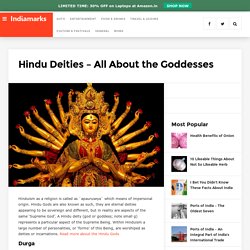
Hindu Gods are also known as such, they are eternal deities appearing to be sovereign and different, but in reality are aspects of the same ‘Supreme God’. A Hindu deity (god or goddess; note small g) represents a particular aspect of the Supreme Being. Hiranyaksha. The boar avatar Varaha, the third incarnation of Viṣṇu, stands in front of the decapitated body of the demon Hiranyaksha In Hinduism, Hiranyaksha (Sanskrit: हिरण्याक्ष) [golden-eyed] was an Asura of pre-ancient India and the son of Diti and Kashyap.

He was slain by the god Vishnu after he (Hiranyaksha) took the Earth to the bottom of what has been described as the "Cosmic ocean". Vishnu assumed the Avatar of a boar - Varaha and dove into the ocean to lift the Earth, in the process slaying Hiranyaksha who was obstructing Him. The battle lasted one thousand years. He had an elder brother named Hiranyakashipu, who after having undertaken penances which made him incredibly powerful and invincible unless several conditions were met, was later slain by Narasimha, another avatar of Vishnu.
Varaha. Varaha (Sanskrit: वराह, "boar") is the avatar of the Hindu god Vishnu in the form of a boar, succeeding Kurma and preceding Narasimha.
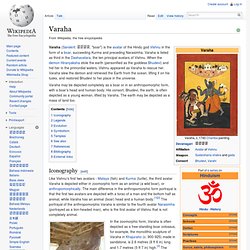
Varaha is listed as third in the Dashavatara, the ten principal avatars of Vishnu. Kalki. In Hinduism, Kalki (Devanagari: कल्कि; meaning 'Eternity,' 'White Horse,' or 'Destroyer of Filth') is the final incarnation of Vishnu in the current Mahayuga, foretold to appear at the end of Kali Yuga, the current epoch.

Religious texts called the Puranas foretell that Kalki will be atop a white horse with a drawn blazing sword. He is the harbinger of the end time in Hindu eschatology, after which he will usher in Satya Yuga. In Buddhist Kalachakra tradition, 25 rulers of the Shambhala Kingdom held the title of Kalki, Kulika or Kalki-king.[3] During Vaishakha, the first fortnight in Shukla Paksha is dedicated to fifteen deities, with each day for a different god. In this tradition, the twelfth day is Vaishakha Dwadashi and is dedicated to Madhava, another name for Kalki. Maha Avatara[edit] There are numerous interpretations of Vedic tradition. Shakti. The goddess Manasa in a dense jungle landscape with a cobra and a swan. Shakti (Sanskrit pronunciation: [ˈʃʌktɪ]) (Devanagari: शक्ति; from Sanskrit shak, "to be able"), meaning "Power" or "empowerment," is the primordial cosmic energy and represents the dynamic forces that are thought to move through the entire universe in Hinduism.[1] Shakti is the concept, or personification, of divine feminine creative power, sometimes referred to as 'The Great Divine Mother' in Hinduism.
On the earthly plane, shakti most actively manifests through female embodiment and creativity/fertility, though it is also present in males in its potential, unmanifest form.[2] Not only is Shakti responsible for creation, it is also the agent of all change. Shakti is cosmic existence as well as liberation, its most significant form being the Kundalini Shakti,[3] a mysterious psychospiritual force.[4] Shakti exists in a state of svātantrya, dependence on no one, being interdependent with the entire universe. Venkateswara. The temple is located upon a range of seven hills representing the seven heads of Adisesha, thus earning the name Seshachalam. The seven peaks are called Seshadri, Neeladri, Garudadri, Anjanadri, Vrushabhadri, Narayanadri and Venkatadri.
The temple is on Venkatadri (also known as Venkatachala or Venkata Hill), the seventh peak, and is also known as the "Temple of Seven Hills", and the abode of the presiding deity.[2] The temple lies on the southern banks of Sri Swami Pushkarini, a holy water tank. The temple complex comprises a traditional temple building, with a number of modern queue and pilgrim lodging sites.[3] The temple is amongst the richest and the most visited holy place in the world.[4] Replica of Lord Venkateswara at Dwaraka Tirumala, Andhra Pradesh Etymology[edit] The name Venkateswara stems from the Indian language of Sanskrit where Vem translates to Sin,[5] "Kata translates to destruction,[5] and Ishwara translates to Supreme Lord.
Legend[edit] See also[edit] References[edit] Hindu Contribution to Mathematics & Science - Archna Sahni. Temples. Concepts.